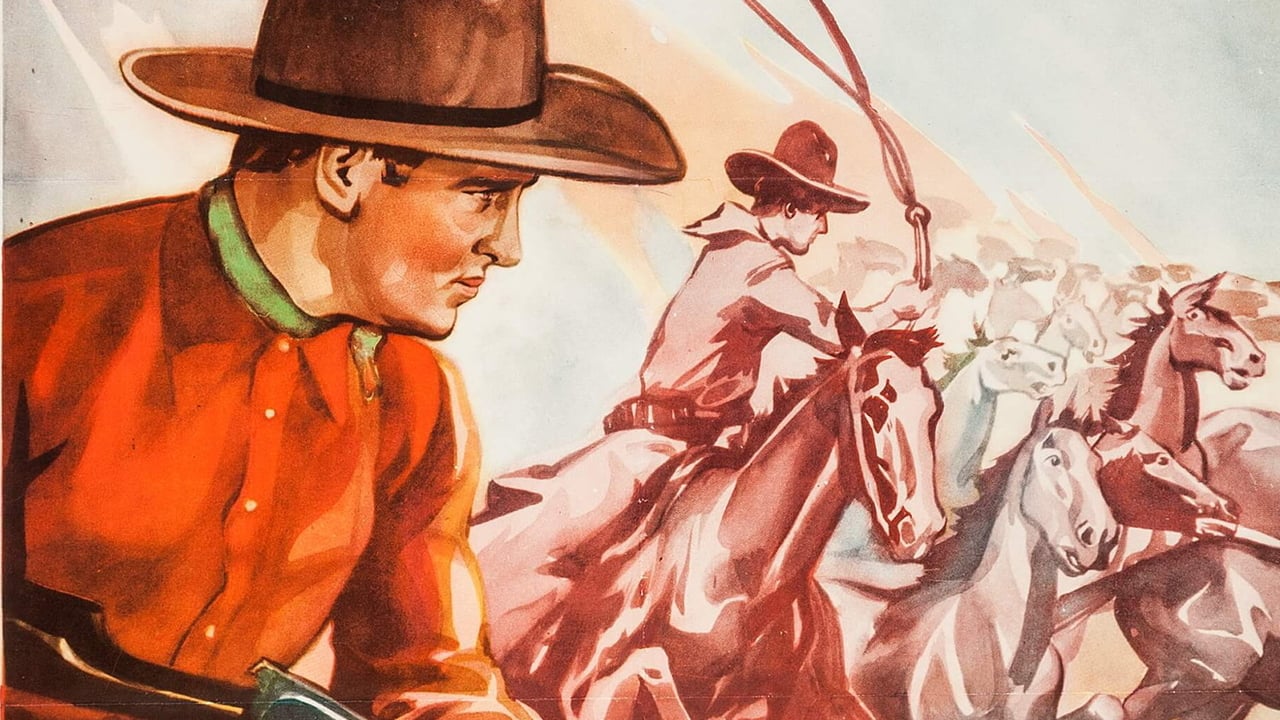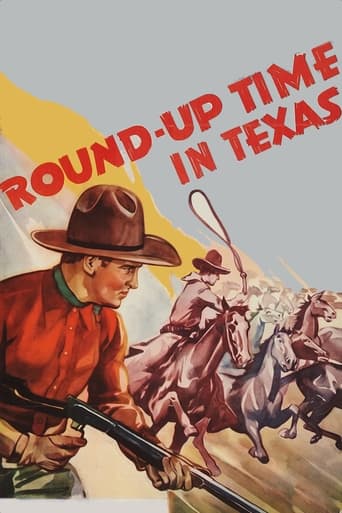

Self-important, over-dramatic, uninspired.
... View MoreThe movie's neither hopeful in contrived ways, nor hopeless in different contrived ways. Somehow it manages to be wonderful
... View MoreThe tone of this movie is interesting -- the stakes are both dramatic and high, but it's balanced with a lot of fun, tongue and cheek dialogue.
... View MoreThis film is so real. It treats its characters with so much care and sensitivity.
... View MoreCopyright 8 February 1937 by Republic Pictures Corp. No recorded New York opening. U.S. release: 28 February 1937 and 22 April 1937. U.K. release through British Lion. No Australian theatrical release. 7 reels. 63 minutes. (Also listed at 58 minutes).SYNOPSIS: Texas? See review below.NOTES: Autry's 16th of his 94 movies.COMMENT: Round-Up Time in Texas refers to the song sung by Autry and his saddle-pals immediately the film opens. After this initial burst of melody, the scene abruptly shifts to Dunbar (sic), South Africa where it remains for the rest of the film. Despite the novelty of the setting (which is used to introduce a few ancient wild animal clips including one in which an obviously process screen lion makes for the camera) and the fact that Gene has a brother, Tex Autry, (actually he doesn't figure overmuch in the story) this is a rather tame and dreary affair. You can trust Gene to sing a song at the drop of a hat and you can rely on Smiley to perpetrate a lot of foolery - in this case, escaping from the clutches of a music-loving native chief. There's also a what's a nice girl like you doing in a place like this heroine (this thought is never expressed but it is obvious nonetheless) played in an extremely colorless fashion by Maxine Doyle. The villain, alas, is also none too interestingly played (LeRoy Mason) and though Earl Hodgins contributes a characteristically breezy study (complete with phoney Cockney accent), acting generally is unengaging. Autry's eyes have been circled with black rings, probably to give him a more rugged appearance, which is unsuccessful in view of the fact there is virtually no action in the film at all - for a time it looks as though Autry's double isn't even going to do his customary stunt of riding after a runaway wagon - but would you believe this familiar little act forms the larger part of the action climax! Kane's direction seems quite ordinary and uninterestingly pedestrian, the photography is flat. Other credits are likewise undistinguished and production values rate no more than average by "B" western standards.
... View MoreGene delivers horses to a diamond mine in, where else, but darkest Africa.The only thing I can figure is that some careless studio secretary got the pages of an Autry western mixed up with a Tarzan script. How else to explain the lunacy of our cowboy heroes meeting up with an "ooga-booga" tribe of witch-doctors in darkest Africa. Somehow, it's weirdly entertaining since you don't know what sort of craziness comes next—gorillas, lions, or flame- throwers. There're a number of good bits even if the premise is wacko— some tuneful songs, the charming Cabin Kids, plus Burnette and Hodgins doing their amusing bits, including a crash-bang finale. I'm just wondering how many ticket-buyers in 1936 left the theater wondering if their maps had gotten Texas all wrong. Oh well, like the movie or not, it sure isn't your typical matinée fare.
... View MoreDespite the title, almost none of the film is set in Texas! Now here is where the film gets REALLY weird--it's supposed to take place in South Africa! Yes, Gene Autry, his horse Champion and his faithful sidekick Smiley Burnett in South Africa! And, the overall product looks a lot like a B-western merged with a Tarzan flick! Talk about strange! The film begins back in the States. Gene receives a letter from his brother* saying that they really need livestock in South Africa and they can get top dollar for them. So, he and Smiley head across the ocean. However, when they arrive they can't find the brother--he has disappeared after some evil claim-jumpers killed his partner and did goodness knows with him. So, in the process of investigating the disappearance, the baddies try to stop him--leading, naturally, to the somewhat exciting conclusion.Seeing Gene on his horse chasing baddies and then a moment later rushing about a thick jungle set is surreal to say the least. And, seeing Smiley doing fire-eating tricks as well as leading musical group supposedly made up of the Chief's kids really gave this movie a strangeness that made my brain hurt. Still, it was fun and kept my attention and is worth seeing if you like Gene Autry films. Others, however, might not be very impressed or be a bit offended by the stereotypical behaviors of the 'natives' or the use of the 'K-word' (I don't think IMDb would let me use this derogatory word for African Blacks--but to many it's about as offensive as the 'ol 'N-word' in the USA. And, I have been to South Africa and this sure looked NOTHING like the real McCoy--more like extras and props from a Tarzan picture!FYI--The guy playing Gene's brother was NOT his actual real-life brother--just some actor.
... View MoreNow of course you would think that a film entitled Round-Up Time In Texas starring Gene Autry would be located in the Lone Star State. Not by a longshot. In this film Gene gets a telegram from his brother Tex Autry who's over in South Africa where he and a partner have made a rich diamond strike. Tex tells Gene to send over 50 head of Texas cow ponies and what he can't use he'll auction off. Hard to believe that in 1937 he would have to send over to Texas for horses, but Gene gets the message and he and Smiley Burnette board a boat from Galveston to Capetown. And then they head to the town of Dunbar where Tex was heard from.Traditional cowboy villain LeRoy Mason maybe operating in South Africa, but he's not lost any nastiness. He and a native gang ambush Tex and his partner and kill the partner and frame Tex. Gene arrives and hears Tex is wanted for murder. Autry's on the hunt now.One of my big pet peeves about films from Hollywood dealing with Africa is that a couple of generations of Americans got their ideas about Africa from films like this. In this film for instance the term "kaffir" is used to describe the native population. Back in 1937 I'll bet those in charge of Republic Pictures from Herbert J. Yates on down had no idea that that word was a term of disparagement as bad as the "n" word in America. They should have known better, but few in America knew anything about Africa.The natives in the film behave like a combination of stereotyped blacks in American located films and American Indians in those same films. Looks ridiculous. You will also not hear one person sound like they come from South Africa. The closest you get is American western character actor Earl Hodgins who talks like a London cockney. The voortrekkers in South Africa used covered wagons like our American Conestogas and I suppose a saloon is a saloon anywhere on planet earth. So maybe knowing this, Yates felt secure in making a South African locale picture for his number cowboy star.I did learn one thing though from Round Up Time in Texas. I learned the origin of the song When the Bloom is on the Sage which Gene Autry sings and includes the title of the film. I had Bing Crosby's record of it and it's a nice western ballad. Gene does well by it too.If this god awful film ever made it to Johannesburg, Capetown, or Pretoria they must have been rolling in the aisles with laughter at the dumb American's idea of their country.
... View More